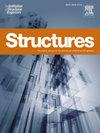Damage dispersion study of high-speed railway track-bridge system with the UCSD considering train effects
IF 3.9
2区 工程技术
Q1 ENGINEERING, CIVIL
引用次数: 0
Abstract
High-speed railway track-bridge systems (HSRTBSs) are subject to rigorous safety performance criteria. Components within the bridge and track structures, such as bearings and CA mortal layer, are susceptible to severe damage during earthquakes, probably compromising running safety. An available way to control seismic response is installing damping devices. However, few research focuses on the contribution of dampers to response of HSRTBS considering train effects. This paper delineates the development of a finite element model of a five-span simply-supported HSRTBS, augmented with prefabricated and modularized U-shaped combined steel dampers (UCSDs), via OpenSees. A high-speed train, running on the HSRBTS, is simulated through the moving spring mass column method (MSMCM). An innovative index, damage dispersion (), is proposed based on the seismic fragility analysis of two groups of components, categorized by their relative fragility in the HSRBTS, to probabilistically assess the impact of the dampers on seismic damage distribution among the system. The result shows that the UCSDs effectively disperse damage from more vulnerable components (fixed bearings, sliding layers, and CA mortar layers) to stronger ones (piers and fasteners). The observed decrease in the median and standard deviation of , identified as a logarithmic normal distribution, implies that UCSDs contribute to a more uniform damage distribution across the system, even when train effects are considered. The variation trend of with PGA shifts from an increase to a modest decline, and the values of exhibit a systematic reduction after considering train running, partially attributable to the train bogies in dissipating energy.考虑列车效应的 UCSD 高速铁路轨道桥系统损伤分散研究
高速铁路轨道桥梁系统(HSRTBSs)必须符合严格的安全性能标准。桥梁和轨道结构中的部件,如支座和 CA 防震层,在地震中很容易受到严重破坏,从而影响运行安全。安装阻尼装置是控制地震响应的一种可用方法。然而,考虑到列车效应,很少有研究关注阻尼器对 HSRTBS 响应的贡献。本文通过 OpenSees 描述了五跨简单支撑 HSRTBS 有限元模型的开发过程,该模型安装了预制和模块化 U 型组合钢阻尼器 (UCSD)。在 HSRBTS 上运行的高速列车通过移动弹簧质量柱法 (MSMCM) 进行模拟。根据两组部件的地震脆性分析(按其在 HSRBTS 中的相对脆性分类),提出了一个创新指标--损伤分散(),以概率评估阻尼器对系统中地震损伤分布的影响。结果表明,UCSDs 有效地将破坏从较脆弱的构件(固定支座、滑动层和 CA 砂浆层)分散到较坚固的构件(桥墩和紧固件)。在对数正态分布中观察到的中位数和标准偏差的减少,意味着即使考虑列车效应,UCSD 也能使整个系统的损坏分布更加均匀。PGA 的变化趋势从上升转为小幅下降,在考虑列车运行后,PGA 的值呈现系统性下降,部分原因是列车转向架在耗散能量。
本文章由计算机程序翻译,如有差异,请以英文原文为准。
求助全文
约1分钟内获得全文
求助全文
来源期刊

Structures
Engineering-Architecture
CiteScore
5.70
自引率
17.10%
发文量
1187
期刊介绍:
Structures aims to publish internationally-leading research across the full breadth of structural engineering. Papers for Structures are particularly welcome in which high-quality research will benefit from wide readership of academics and practitioners such that not only high citation rates but also tangible industrial-related pathways to impact are achieved.
文献相关原料
| 公司名称 | 产品信息 | 采购帮参考价格 |
|---|
 求助内容:
求助内容: 应助结果提醒方式:
应助结果提醒方式:


